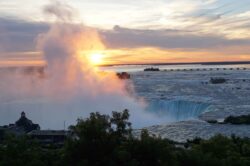Studio Staples: Strategic Plein Air Sketching

Don’t let the challenges of shifting light and complex scenery derail your plein air paintings. The key is to start with a strategic preliminary sketch. This isn’t about creating a finished drawing, but about quickly analyzing the scene to form a confident plan. A simple versatile drawing kit can be an essential tool for the outdoor studio. Here, I’ve been exploring the Caran d’Ache Technalo graphite set. It’s a simple tin of water-soluble graphite pencils and waterbrush, along with a range of values as well as red, green, and blue tinted graphite. Let’s break down a simple, three-sketch approach to help you conquer any landscape.


Sketch 1: Contour Line Sketch
The first sketch helpd me familiarize myself with the skeleton of the scene. Before I explore the light and shadow, I’m looking to understand the forms they fall upon. Using one of the classic graphite pencils from the set, I begin with a simple line study. The goal here is not to render every detail, but to use contour lines to divide the major shapes of the landscape. This process forces me to slow down and truly see the edges where the mountain meets the sky, where the trees define the foreground, and where the distant peaks recede.
This linear exploration is invaluable for contemplating the composition. Are the primary lines leading the viewer’s eye effectively? How do the proportions of the mountain range relate to the expanse of the sky? This simple line drawing acts as a map, helping to navigate the complexities of the scene and make informed decisions about the arrangement of elements before moving onto the painting.

Sketch 2: Light and Shadow Sketch
With the composition established, the next sketch shifts my focus from lines to shapes—specifically, the shapes created by light and shadow. This is where the range of values is helpful. This isn’t about subtle gradations; it’s about identifying the major masses of light and dark. This practice is a powerful tool for pressure-testing the composition. Does the arrangement of values create a pleasing and balanced design? A strong value structure is the backbone of a compelling painting, and this quick study allows me to simplify the scene into its most basic forms, ensuring a solid foundation for the subsequent layers of color.

Sketch 3: Color Temperature and Brushwork
For the third sketch, I incorporate the red, green, and blue tinted water-soluble graphite pencils, along with a water brush. This allows for a preliminary exploration of color temperature and handling. The early light from this scene in Rocky Mountain National Park create a range of blues and purples in the shadows and warm greens and reds in the sunlit areas.
By lightly sketching with the tinted pencils, I can begin to think about the overall color harmony of the final piece. Then, with a few strokes of the water brush, the graphite transforms. The lines soften, the colors bloom, and I can get a feel for the types of brushwork I might employ. This allows me to explore the edges—dissolving a hard line into a soft, atmospheric transition or leaving a crisp edge to define a foreground element. This step bridges the gap between drawing and painting, building a tangible link to the final work.

By investing just a few minutes in these three strategic sketches, my understanding of the scene is deepened. I’ve analyzed the composition as a series of interconnected shapes, values, and temperatures that I am now prepared to translate into a painting. Adding a versatile set of water-soluble pencils to your plein air kit is more than just carrying extra gear; it’s about embracing a mindset of thoughtful preparation that leads to more confident, expressive, and ultimately more successful paintings.
 Artists Network Membership - 1 Month
Artists Network Membership - 1 Month  Breakthrough Paint Along: Where Mixed Media Combine Together
Breakthrough Paint Along: Where Mixed Media Combine Together  Paint Along 127: Paint the Motion of the Sea
Paint Along 127: Paint the Motion of the Sea  Paint Along 126: Simplify Your Landscapes with a Limited Palette
Paint Along 126: Simplify Your Landscapes with a Limited Palette 















Join the Conversation!